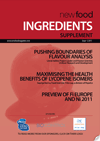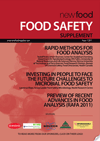Hygienic design requirements for components in hygienic and sterile processes
4 January 2012 | By Ulf Thiessen and Matthias Schäfer, EHEDG Subgroup Valves
The major objective of hygienic design is to avoid product contamination by microbes, particles and chemicals. European legislation (i.e. the Machinery Directive) is forcing machinery suppliers to design their machines which are used in the production of food, pharmaceuticals and cosmetics according to some so-called hygienic design criteria. The common…







